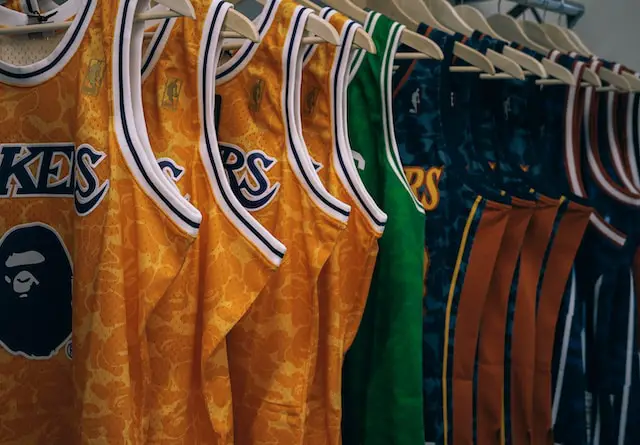Breakaway jerseys are made from much lighter and breathable material while Authentic jerseys are designed to be exact replicas of the player’s on-field jersey
Breakaway jerseys
(Photo by Constantin Shimonenko on Unsplash )

Breakaway jerseys, also known as tearaway jerseys, are a type of sports jersey commonly worn in various team sports, such as ice hockey or basketball. The primary characteristic of breakaway jerseys is that they are designed to easily come apart or tear away from the wearer’s body in specific situations.
The purpose of breakaway jerseys is to enhance player safety. In high-intensity sports like hockey, there can be instances where players’ jerseys can become entangled, leading to potential injury or restricting their movement. Breakaway jerseys mitigate this risk by allowing the jersey to quickly and easily detach from the player’s body if it gets grabbed or pulled forcefully.
Breakaway jerseys typically consist of two main components: the outer layer and the fasteners. The outer layer is made of the same material as a regular jersey and features the team’s logo, colors, and player number. The fasteners are strategically placed along the sides and/or shoulders of the jersey and hold the two sides together.
The fasteners used on breakaway jerseys are designed to be secure during regular gameplay but can easily come undone with a significant amount of force. The fasteners can vary depending on the sport and brand but commonly include snaps, Velcro, or specially designed hooks and loops.
When a player’s breakaway jersey is grabbed or pulled forcefully, the fasteners release, causing the jersey to tear away from the player’s body. This swift detachment allows the player to continue playing without being hindered by the jersey or risking injury due to entanglement.
Breakaway jerseys are primarily used in sports where physical contact is prevalent and where the potential for jersey grabbing or holding is high. Apart from ice hockey and basketball, they are also used in sports like lacrosse or American football. These jerseys are often reserved for specific game situations, such as fights or altercations in ice hockey, where there is a higher likelihood of a player’s jersey being pulled or tugged.
In summary, breakaway jerseys are specially designed sports jerseys that can easily tear away from the wearer’s body when subjected to force. They are intended to enhance player safety by reducing the risk of injury due to jersey grabbing or entanglement during intense gameplay.
Authentic jerseys
Authentic jerseys, also known as game-issued or game-worn jerseys, are high-quality jerseys that are worn by professional athletes during official games or events. These jerseys are typically produced and authorized by the league or team and are considered to be the most genuine and official representation of a team’s uniform.
The term “authentic” implies that these jerseys are identical to the ones worn by the players on the field or court. They are designed to meet the highest standards of quality, craftsmanship, and accuracy in terms of team colors, logos, and player details. Authentic jerseys are often sought after by sports enthusiasts, collectors, and fans who want to own a piece of memorabilia directly associated with their favorite teams or players.
Here are some key features and characteristics of authentic jerseys:
Materials and Construction: Authentic jerseys are typically made using premium materials to ensure durability and performance. They often feature advanced fabric technologies that enhance breathability, moisture-wicking, and comfort for the athletes during gameplay.
Accurate Design: Authentic jerseys are meticulously designed to replicate the exact appearance of the team’s uniform. The colors, logos, and insignia are carefully reproduced to match the official specifications. This attention to detail ensures that the jersey is an accurate representation of the team’s on-field or on-court look.
Player Details: Authentic jerseys often include specific player details such as the player’s name, number, and sometimes even patches denoting achievements or honors. These details are usually stitched or heat-pressed onto the jersey to provide a high-quality and long-lasting finish.
Game-Worn or Game-Issued: Authentic jerseys can be categorized as either game-worn or game-issued. Game-worn jerseys are jerseys that have been worn by a player during an official game. These jerseys carry added sentimental and historical value, as they have been directly used in actual competitions. Game-issued jerseys are jerseys that have been produced for players but might not have been worn during a game. They are still considered authentic and hold value due to their association with the team and player.
Limited Availability: Authentic jerseys are often produced in limited quantities, making them more exclusive and desirable. They are typically sold through official team stores, authorized retailers, or special auctions. The limited availability contributes to their collectible nature and higher market value.
Certificates of Authenticity: To ensure the legitimacy of an authentic jersey, certificates of authenticity (COAs) are often provided. These documents verify that the jersey is an officially authorized product and, in the case of game-worn jerseys, confirm the specific game or event in which the jersey was worn.
It’s important to note that authentic jerseys are generally more expensive compared to replica or fan jerseys due to their higher quality, official licensing, and association with professional sports leagues and teams.
Authentic jerseys are premium-quality, officially authorized jerseys that accurately replicate the team uniforms worn by professional athletes during official games. They are sought after by fans, collectors, and enthusiasts due to their genuine representation of the team and their association with specific players or events.
The history of jerseys
(Photo by Alex Haney on Unsplash )

The history of jerseys dates back to the late 19th century when organized team sports began to gain popularity. Here is a brief overview of the evolution of jerseys:
Early Beginnings: In the early days of team sports, players typically wore their own clothing, which often consisted of long-sleeved shirts, trousers, and sometimes caps. There was no standardized uniform, and teams would often wear similar colors or ribbons to identify themselves.
Wool Jerseys: In the early 20th century, as team sports became more organized, jerseys started to emerge. Wool was the primary material used for jerseys during this time, as it provided warmth and durability. These jerseys were typically long-sleeved and featured a button-up or lace-up front. They often had a simple design with the team’s colors and sometimes a logo or emblem.
Evolution of Materials: As sports apparel technology progressed, jerseys began to incorporate new materials. In the 1930s and 1940s, jerseys started to be made from synthetic fabrics such as rayon and nylon. These materials were lighter, more breathable, and allowed for better mobility on the field.
Logo and Number Placement: In the mid-20th century, teams started adding logos or emblems to their jerseys. These logos represented the team’s identity and were typically placed on the front or chest area of the jersey. In addition, player numbers began to be introduced on the back of jerseys, aiding in player identification.
Revolution of Designs: From the 1960s onwards, jerseys saw more diverse and creative designs. Bold colors, stripes, and patterns became common, reflecting the evolving fashion trends of the time. Teams started to experiment with different styles to create a unique and recognizable look.
Sponsorship and Branding: In the 1970s and 1980s, commercialization entered the world of sports jerseys. Sponsors and brands began to appear on jerseys, either as logos or as advertisements. This trend grew over time, and today it is common to see prominent sponsor logos on the front or sleeves of jerseys.
Technological Advancements: In recent decades, advancements in sports apparel technology have revolutionized jerseys. Performance fabrics with moisture-wicking properties, lightweight materials, and strategic ventilation have become standard. These innovations enhance player comfort and performance on the field while maintaining the traditional aesthetic appeal of jerseys.
Fan Jerseys: Alongside the evolution of on-field jerseys, fan jerseys have become immensely popular. These replicas allow fans to show support for their favorite teams and players. Fan jerseys are typically less expensive than authentic jerseys and are designed for everyday wear rather than active gameplay.
Today, jerseys continue to be an integral part of team sports, representing team identity, player recognition, and fan loyalty. They have become iconic symbols in the world of sports, with rich histories and a significant cultural impact.
Which is better – Breakaway jerseys or Authentic jerseys?
The most important factor to consider when choosing between breakaway and authentic jerseys is the level of play you will be using the jersey for. If you are playing in a lower division or recreational league, then a breakaway jersey will most likely serve your purpose, These jerseys are less expensive and are designed to tear away at the shoulders and arms when pulled, which prevents players from getting tangled up.
However, if you are playing in a higher division or competitive league, then an Authentic jersey is necessary. Authentic jerseys are more expensive but they are also much more durable. They are designed to withstand the rigors of competitive play and will not tear away easily like breakaway jerseys.
Featured Image By – Abhay siby Mathew on Unsplash







